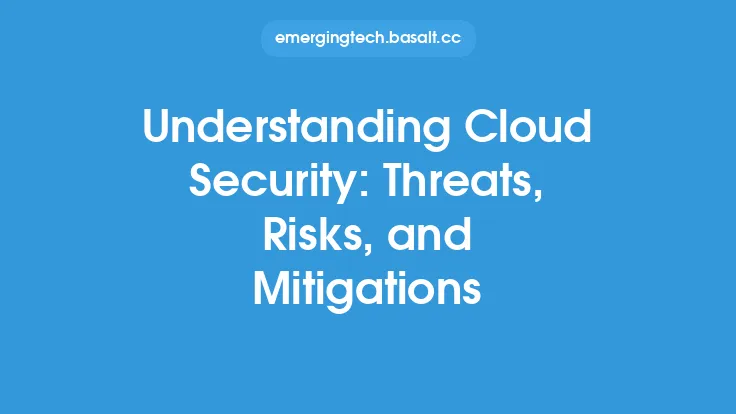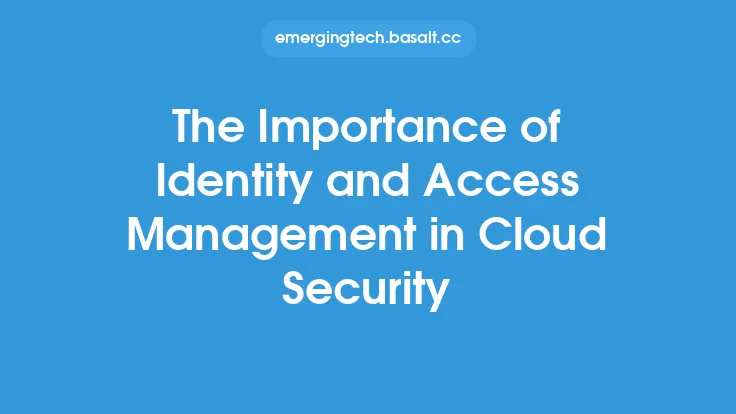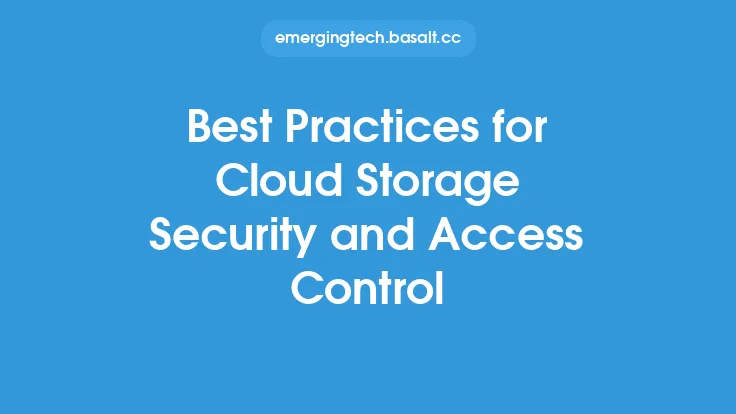As the world becomes increasingly digital, the importance of cloud security awareness and training cannot be overstated. With more and more businesses moving their operations to the cloud, the risk of cyber threats and data breaches has never been higher. However, by empowering users with the knowledge and skills they need to stay safe in the cloud, organizations can significantly reduce the risk of security incidents and protect their sensitive data.
The Importance of Cloud Security Awareness
Cloud security awareness is critical for any organization that uses cloud-based services. This is because the cloud is a shared responsibility model, where the cloud provider is responsible for securing the infrastructure, but the customer is responsible for securing their data and applications. If users are not aware of the potential risks and threats associated with cloud computing, they may inadvertently put their organization's data at risk. For example, using weak passwords, clicking on phishing emails, or uploading sensitive data to unsecured cloud storage services can all lead to security breaches. By providing users with cloud security awareness training, organizations can educate them on the potential risks and threats associated with cloud computing and how to mitigate them.
Cloud Security Training: What to Cover
Cloud security training should cover a range of topics, including the basics of cloud computing, cloud security risks and threats, and best practices for securing cloud-based data and applications. Some of the key topics that should be covered in cloud security training include:
- Cloud security fundamentals: This includes an overview of cloud computing, the different types of cloud services (IaaS, PaaS, SaaS), and the shared responsibility model.
- Cloud security risks and threats: This includes an overview of the potential risks and threats associated with cloud computing, such as data breaches, phishing attacks, and denial-of-service (DoS) attacks.
- Cloud security best practices: This includes guidance on how to secure cloud-based data and applications, such as using strong passwords, enabling two-factor authentication, and encrypting sensitive data.
- Cloud security policies and procedures: This includes an overview of an organization's cloud security policies and procedures, such as incident response plans and data backup and recovery procedures.
Delivering Cloud Security Training
Cloud security training can be delivered in a variety of ways, including online courses, instructor-led training, and phishing simulations. The key is to make the training engaging and interactive, so that users are motivated to learn and retain the information. Some best practices for delivering cloud security training include:
- Making the training relevant and applicable to the user's job function and responsibilities.
- Using real-world examples and case studies to illustrate the importance of cloud security.
- Providing opportunities for users to practice what they have learned, such as through simulations or hands-on exercises.
- Continuously updating and refreshing the training content to reflect the latest cloud security threats and best practices.
Measuring the Effectiveness of Cloud Security Training
Measuring the effectiveness of cloud security training is critical to ensuring that users have the knowledge and skills they need to stay safe in the cloud. Some ways to measure the effectiveness of cloud security training include:
- Quizzes and assessments: These can be used to test users' knowledge and understanding of cloud security concepts and best practices.
- Phishing simulations: These can be used to test users' ability to identify and respond to phishing attacks.
- Security incident response plans: These can be used to test users' ability to respond to security incidents, such as data breaches or DoS attacks.
- User feedback and surveys: These can be used to gather feedback from users on the effectiveness of the training and identify areas for improvement.
The Role of Leadership in Cloud Security Awareness and Training
Leadership plays a critical role in cloud security awareness and training. By prioritizing cloud security and providing resources and support for training and awareness programs, leaders can demonstrate their commitment to protecting their organization's sensitive data and applications. Some ways that leaders can support cloud security awareness and training include:
- Providing funding and resources for training and awareness programs.
- Encouraging a culture of security awareness and responsibility within the organization.
- Leading by example, by demonstrating their own commitment to cloud security best practices.
- Continuously monitoring and evaluating the effectiveness of cloud security training and awareness programs, and making improvements as needed.
Cloud Security Awareness and Training for Different Roles
Cloud security awareness and training should be tailored to the specific needs and responsibilities of different roles within an organization. For example:
- End-users: These users should receive training on cloud security best practices, such as using strong passwords and being cautious when clicking on links or opening attachments.
- IT staff: These users should receive training on cloud security architecture, cloud security risks and threats, and cloud security best practices.
- Developers: These users should receive training on secure coding practices, cloud security risks and threats, and cloud security best practices.
- Managers and executives: These users should receive training on cloud security governance, risk management, and compliance.
Conclusion
Cloud security awareness and training are critical components of any organization's cloud security strategy. By empowering users with the knowledge and skills they need to stay safe in the cloud, organizations can significantly reduce the risk of security incidents and protect their sensitive data. By providing comprehensive and engaging training, continuously measuring and evaluating the effectiveness of training, and prioritizing cloud security awareness and training, organizations can ensure that their users are equipped to navigate the cloud securely and confidently.





